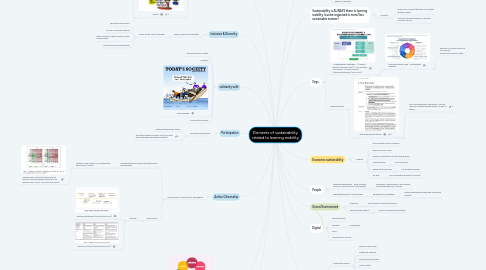
1. Human rights, now and in future
1.1. Justice
1.1.1. fairness, equity
1.1.1.1. reduce inequality
1.1.1.2. haves/have nots
2. Inclusion & Diversity
2.1. who is being most affected?
2.1.1. ability of the most vulnerable
2.1.1.1. have their voice heard
2.1.1.2. access to decision making
2.1.1.3. fewer resources, fewer choices, fewer opportunities
2.1.1.4. most at risk of climate change
3. solidarity with
3.1. humans as part of nature
3.2. cohesion
3.3. using privilege
3.4. concept of solidarity
4. Participation
4.1. involving young people
4.1.1. creating/owning their space
4.1.2. they need support to play a role (EYF push with sustainable development topic)
5. Active Citizenship
5.1. Young people's focus/voices being heard
5.1.1. marches/fridays for future recognised and incorporated
5.1.1.1. Distrust in the system. if not listened to, democracy is failing
5.1.1.1.1. Governments cannot be relied upon to solve our environmental problems (from Gorman 2021 report - De Moor et al 2020)
5.1.2. Greta effect
5.1.2.1. activism
5.1.2.1.1. global youth strikes (from Gorman 2021)
5.1.2.1.2. types of activism (from Gorman 2021)
6. Well-being
6.1. 8 dimensions (Swarbrick, from Coyote article Monika)
6.1.1. Youth progress index from European Youth Forum - not measuring through GDP
7. Social sustainability
7.1. in blue
8. Concept
8.1. "“Sustainability in learning mobility” means aligning operations of a given learning mobility organisation on the procedural level with environmental, social and economic sustainability principles."
8.2. explore and understand
8.2.1. awareness and competence (ability and capability) to work with sustainability
8.3. apply it in practice
9. Sustainability is ALWAYS there in learning mobility (can be organised in more/less sustainable manner)
9.1. Projects
9.1.1. End focus: projects that have a an output directly related
9.1.2. Process: becoming greener in the way mobility is done
10. Orgs
10.1. : Susatainability strategies - 1) lead by example (PROCESSES) 2) run activities (CONTENT) 3) build capacity (internally/externally. (ACTIVISM)
10.1.1. Learning Mobility Orgs - sustainability strategy
10.1.1.1. become an activist structure to influence community/soceity further
10.2. measure impact
10.2.1. global reporting intiiative
10.2.1.1. SDG Global indicator framework - do your Learning Mobility projects feed in to any of these?
11. Economic sustainability
11.1. funding
11.1.1. procurement & anti-corruption
11.1.2. efficient use of funds
11.1.3. choice of where/how to use funds gained
11.1.4. municipal level
11.1.4.1. link to policies
11.1.5. regional/national level
11.1.5.1. link to other policies?
11.1.6. EU level
11.1.6.1. link to European policies / SDGs etc
12. People
12.1. Different stakeholders - have different SWOTs in connection to sustainability
12.1.1. Individuals, organisations, communities, funding programmes, policies,
12.2. organisational staff / youth leaders
12.2.1. participants of mobilities
12.2.1.1. other profesionnals connected to learning mobility
13. Green/Environment
13.1. travelling
13.1.1. less pollution & carbon emissions
13.2. environmental impact
13.2.1. choices of resources/activities
14. Digital
14.1. Remote/online
14.2. blended
14.2.1. combination
14.3. tools
14.4. Learning from Corona
15. Impact
15.1. Community impact
15.1.1. before, during, after
15.1.2. bridging & bonding
15.1.3. incoming communities
15.1.4. social capital
15.1.5. cross-sectorial link
15.1.6. individuals, organisations, neighbourhood, community, society
15.2. Long term impact
15.2.1. networks
15.2.2. resources
15.2.3. longer term funding
15.2.4. recognition
15.2.5. advocacy & activism
15.2.6. system change / policy change
